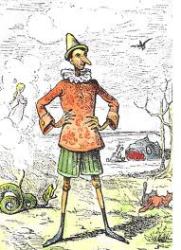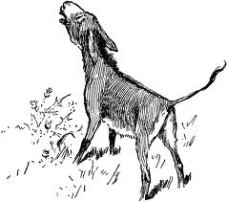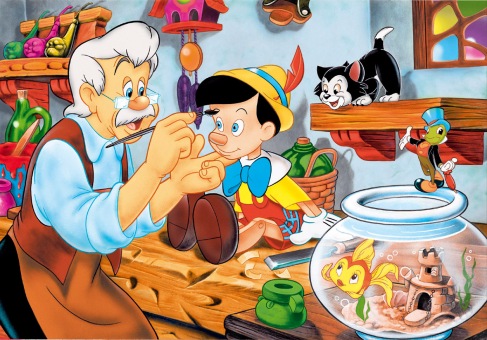Peter Pan. Now isn’t he the little charmer. Oh sorry, I meant self-satisfied, cocky jerk. While this quality of overwhelming arrogance isn’t exactly uncommon in eternal beings (looking at you Zeus!) it seems to be Peter’s defining characteristic. While reading the book I was struck by how pleased with himself Peter seems. He’s never shy to brag about his achievements; even if he’s technically taking credit for someone else’s work Peter will still crow away. And then it hit me: crowed. How many times throughout Peter and Wendy was the term “crow” or some variant of that used to show Peter exulting over his own brilliance? And was it used solely for when he is bragging?

A Peter Pan face character at Disney
The first time Peter crows occurs on page 90 just after Wendy has sewed his shadow back on. He immediately has forgotten that it was Wendy who solved his predicament. “How clever I am,’ he crowed rapturously, ‘oh, the cleverness of me!” Ignoring the fact that he sounds exactly like that kid back in elementary school who would brag about getting an A on the first multiplication test, and we all knew that kid, I think it is very interesting that the first use of this term “crowed” occurs with Peter taking credit for someone else’s actions.
On page 125 the Lost Boys hear Peter crow twice to announce his return to Neverland. While this at first seems to be a simple greeting when Peter talks to the boys a few lines later he questions why they have not cheered about his homecoming. Thus the crow was used to cue the adoration of the Lost Boys, further stoking Peter’s ego, and when it was not forthcoming Peter was piqued.
On page 144 Wendy has clearly come to understand Peter’s need to exult over his achievements because after he has tricked the pirates into releasing Tiger Lily she thinks: “…she knew that he would be elated also and very likely crow,” and she quickly covers his mouth before it can escape. It is later revealed on this page that while Peter may have wished to crow in excitement and pride over his latest victory over the pirates he instead whistles in surprise due to Captain Hook arriving. It’s interesting that Wendy, who has only known Peter for a short time, is able to recognize when he will boast so maybe we can imagine that in the time the narrator has skipped Wendy witnessed many other crowing episodes.
Soon after the last instance Peter is goaded by Captain Hook and the pirates to reveal himself as the alternate Hook. He gleefully cackles at them as they continue to “guess” his identity incorrectly until finally: “Can’t guess, can’t guess,’ crowed Peter. ‘Do you give it up?” Peter’s pride and cockiness brings him to reveal himself to Hook and the pirates, which leads to him and Wendy almost dying.

Peter Pan, you cocky jerk.
On page 155 Peter has been saved by the Never bird, who gave up her floating nest so that he wouldn’t drown. When Peter moves her eggs to a watertight hat the Never bird “screamed her admiration of him; and, alas, Peter crowed his agreement with her.” So once again the term crowed is linked with Peter bragging about himself.
On page 197 the Lost boys and the pirates hear “a crowing sound” come from the cabin on the pirate ship. The Lost boys recognize it as Peter exulting over his latest victory of killing Jukes.
Again on page 198 they hear the crow sound after Peter kills another pirate in the cabin
On page 200 Peter has made his way from the cabin to the deck of the ship where he releases Wendy. After she is safe he took her place at the mast and then “he took a great breath and crowed.” Here he is again using the crow to announce his presence but also to brag about how he has outwitted the pirates by killing two of them and letting loose their captives right under their noses.
On page 222 Wendy says that Peter’s last words to her were “Just always be waiting for me, and then some night you will hear me crowing.” Again the crow is used as a greeting but also it shows Peter’s arrogance that Wendy should always wait for him and some night, it could be any night at all, he’ll show up again.
On page 223 Wendy, now a mother herself (for real this time), hears a crow come from the nursery where her daughter Jane is supposedly sleeping.
The final crow of the book is on page 225 when Wendy returns to the nursery to find Peter “sitting on the bedpost crowing gloriously, while Jane in her nighty was flying round the room in solemn ecstasy.” The crow has come full circle now except I believe there is a big difference between the first and last use of the term. While they both take place in the same nursery the first use is after Peter takes credit for someone else’s cleverness. The last time, in my opinion, is both an exultation over his cleverness in teaching Jane how to fly but also for Jane’s success. He is pleased with himself but also pleased to see Jane so happy to see her enjoying flying so much.
So there you have it: throughout the novel Peter was a crowing machine, it was how he bragged about his achievements and also how he would ask for recognition of his accomplishments. I like this use of crow because while it does capture the image of Peter laughing or screaming uproariously over his cleverness it also hearkens back to Peter Pan in Kensington Gardens when Peter was just a baby who used to be a bird.
Please click HERE for an awesome example of Peter crowing, courtesy a face character at Disney!







 In Chapter 3 of Collodi’s published novel, Pinocchio is carved out of wood, and as soon as Old Joe got to work on the nose, it started to grow longer and longer. At this point he had not carved out Pinocchio’s mouth yet, and so the reason for the growth in this first appearance is not lying. However, when Pinocchio has recovered at the Fairy’s house in Chapter 17, he lies to the Fairy about the location of his gold coins, and with each lie, his nose grows to an obscene length. He cannot even turn in the room without harm. The title of this chapter even bluntly describes his nose lengthening as the resulting negative consequence for lying: “How Pinocchio … tells a lie and as a punishment his nose grows long.” Here are two cases of nose growth in the book, which do not consistently link lying and nose growth.
In Chapter 3 of Collodi’s published novel, Pinocchio is carved out of wood, and as soon as Old Joe got to work on the nose, it started to grow longer and longer. At this point he had not carved out Pinocchio’s mouth yet, and so the reason for the growth in this first appearance is not lying. However, when Pinocchio has recovered at the Fairy’s house in Chapter 17, he lies to the Fairy about the location of his gold coins, and with each lie, his nose grows to an obscene length. He cannot even turn in the room without harm. The title of this chapter even bluntly describes his nose lengthening as the resulting negative consequence for lying: “How Pinocchio … tells a lie and as a punishment his nose grows long.” Here are two cases of nose growth in the book, which do not consistently link lying and nose growth.




